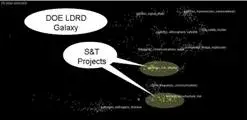 Department of Homeland Security Software Seeks to Harvest Department of Energy Research
Department of Homeland Security Software Seeks to Harvest Department of Energy Research
(April 8, 2009) First responders, frontline border and transportation security officers, and other homeland security professionals looking for the next generation of technology to support their mission rely on world-class laboratories to conduct the research. These laboratories operate in partnership with the U.S. Department of Homeland Security (DHS) and other government agencies. But the sheer number of ongoing lab projects, numbering in the tens of thousands, can be overwhelming for someone trying to navigate the field for the first time.
Instead of relying on plain old human networking to find out what's applicable, what if managers could turn to a search engine known for the depth of its exploration, the accuracy of its algorithm, and the speed of its web crunching? This winning formula is what computer scientists hope to match with new software that helps department managers identify discover ongoing projects at other agencies with potential applications to chemical and biological attacks, explosives, land and sea border crossings, and other areas applicable to homeland security.
The Harvesting Innovation Project is the brainchild of the Office of National Laboratories (ONL) at the DHS Science and Technology Directorate (S&T). The current focus is on combing through Laboratory Directed Research and Development (LDRD) projects representing more than $400 million a year in funding by the Department of Energy (DOE). The hope is that one day the software can be used to search other databases of projects.
"There is a lot of research out there that the Department can benefit from being aware of," said Don Kirkley, who is leading the Harvesting Innovation Project. "We want to make sure that the Department has visibility into and the right S&T investments for its needs. We want to access the work of the more than 30,000 scientists and engineers at the Department of Energy's national labs who are performing cutting-edge research with multi-program capabilities."
One of the Department's responsibilities is to leverage DOE national labs. ONL has adapted powerful visualization software from the Pacific Northwest National Laboratory in Washington, and used it to "harvest" relevant projects in the Laboratory Directed Research and Development program and fuse them with S&T's research focus areas. ONL is also investigating other tools that might help identify other projects to benefit the S&T divisions.
The software displays search results like a space "galaxy," with relevant projects grouped and highlighted together. Early versions of the software yielded some possible matches for the Human Factors program, according to ONL.
"The division program managers can then decide to further pursue these projects and determine if the body of work is worth additional investments for Department of Homeland Security mission alignment," he said.
Since the software is not restricted to searching a single set of data, ONL hopes future versions can search additional projects within DOE and at other federal agencies. It also wants to create a feature that allows program managers to search for specific items of interest right from their desktops, just as they would with a normal web search engine.
Already, there is one potential partner with projects worth searching: The National Aeronautics and Space Administration's Jet Propulsion Laboratory (JPL), the agency's primary research center for space exploration beyond the moon. The Department and JPL are interested in using technology to identify chemicals and living microbes, although they have different motivations for doing so.
"The Department needs to detect chemical and biological threats, and JPL needs to detect chemicals and signs of life on other planets, so it's a perfect alignment from one perspective," said Ed Chow, the JPL program manager for the Department.
Another potential alignment is tunnel detection. When JPL sends robots, rovers, and other machines to other planets it needs to determine if there are large cavities below ground that might hold ice.
Including research from others in the data set like JPL could mean hundreds of millions of dollars in additional projects to cull.
Like a smart angler, ONL wants to put lots of lines in the water. By searching broadly, this software hopes to reel in a catch of the day that can be filleted and fried especially for a Department of Homeland Security feast.
To request more information about any of these stories, please e-mail st.snapshots@hq.dhs.gov
